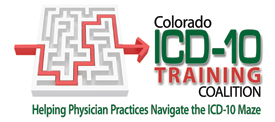ICD-10 deadline Oct. 1
Use the summer to prepare for ICD-10 implementation
by Marilyn Rissmiller, Senior Director, Division of Health Care Financing

With just three months left to transition to the ICD-10 code set, it’s crunch time. Several organizations have resources to get your practice ready for the Oct. 1 deadline. The American Medical Association has made available a handy month-by-month primer for ICD-10. Below are their recommendations for the summer whether your practice is already on the road to implementation or you need a little more guidance.
Just getting started?
Spend the summer identifying the changes you need to make in your practice for ICD-10. For example, you’ll need to update your systems, forms and workflow processes. Pull together all staff members involved in coding, billing, claims processing, revenue management and clinical documentation, then figure out each task necessary to bring your practice in line with the new code set. Ask the group members how and where they use ICD-9, and go from there.
Once you have a plan, you can more easily estimate and secure funds to update your practice management system, purchase new coding guides and send your staff to training. Use a transition checklist like one found on the Colorado ICD-10 Coalition website, www.cms.org/icd-10, to get started.
Then, contact vendors about upcoming changes. Most practices will need vendors to complete system updates to support the new code set. The two largest systems impacted will be your practice management system and your electronic health record system. You also may need to update your e-prescribing module, disease management registry or other systems.
This also is the time to communicate with your payers and related vendors, such as billing offices, and other physician practices and agencies from which your practice may seek advice, assistance or materials. Be sure to ask the insurers you contract with about payment changes, processes for “unspecified” codes and other information.
Already on your way?
ICD-10 requires new levels of documentation requirements, so now’s the time for practices already preparing for ICD-10 to assess their current documentation practices and how they will support the new code set.
The more detailed documentation for ICD-10 coding may not be that different than what you’re already recording in your clinical notes. Also, keep in mind the changes in codes and increased level of detail are specific to specialties. Orthopedics has the highest increase in codes because many are simply separate codes for “right” versus “left.” This information would already be in your documentation.
Decide whether you want to perform the documentation assessment yourself or you would like to get outside expertise. There are organizations that will provide feedback on your current situation and whether it will be sufficient for ICD-10, or you can conduct your own assessment.
Next on your summer to-do list is to test your practice’s ICD-10 readiness and identify potential problems. There are different types of testing and each type serves a different purpose.
- Content-based testing assesses your practice’s documentation and ability to code in ICD-10. It involves being given documentation and coding a clinical scenario in the new code set. The Healthcare Information and Management Systems Society offers resources for your practice on their website, www.himss.org.
- Internal testing evaluates your practice’s ability to create and use ICD-10 codes throughout the patient workflow where you currently use ICD-9 codes. This type of testing requires system upgrades to be installed already and helps you follow the flow of a patient through a visit to see where codes are used. Use this testing to identify any gaps in your ICD-10 updates.
- External testing tests your practice’s ability to send and receive transactions that use ICD-10 codes with your external trading partners, including your billing service, clearinghouse or payers. Check with these groups about their testing plans.
One type of external test is acknowledgement testing with Medicare, which simply acknowledges that a claim has been received. Physicians can do acknowledgement testing with their Medicare Administrative Contractors and the Common Electronic Data Interchange contractor any time up to the Oct. 1 implementation date.
Three bills related to ICD-10 are currently under consideration in the United States Congress. Two contain a delay or repeal of ICD-10 and are unlikely to gain much traction, but one – H.R. 2652, “Protecting Patients and Physicians Against Coding Act of 2015” – has received more attention. It would create a two-year grace period where health care providers’ ICD-10-based claims submitted to Medicare and Medicaid would not be denied due to coding errors. H.R. 2652 had 32 co-sponsors as of June 8, and has been referred to the House Committee on Energy and Commerce as well as the Committee on Ways and Means.
This policy concept was passed by the American Medical Association House of Delegates in early June, with full support by the Colorado delegation to the AMA.
Find ICD-10 resources online on the AMA’s website at www.ama-assn.org/go/icd-10 or on the Colorado ICD-10 Coalition website at www.cms.org/icd-10.
Posted in: Colorado Medicine | Practice Management | Coding and Billing

Comments
Please sign in to view or post comments.